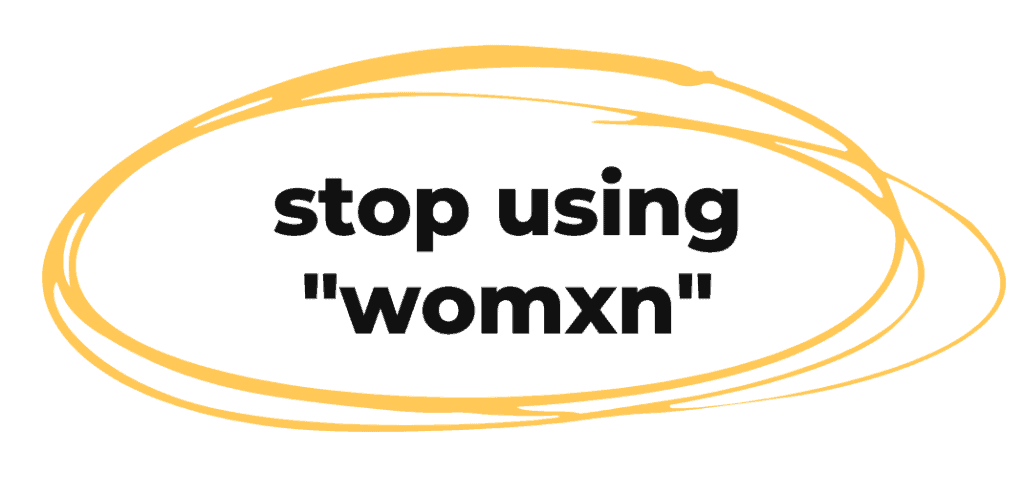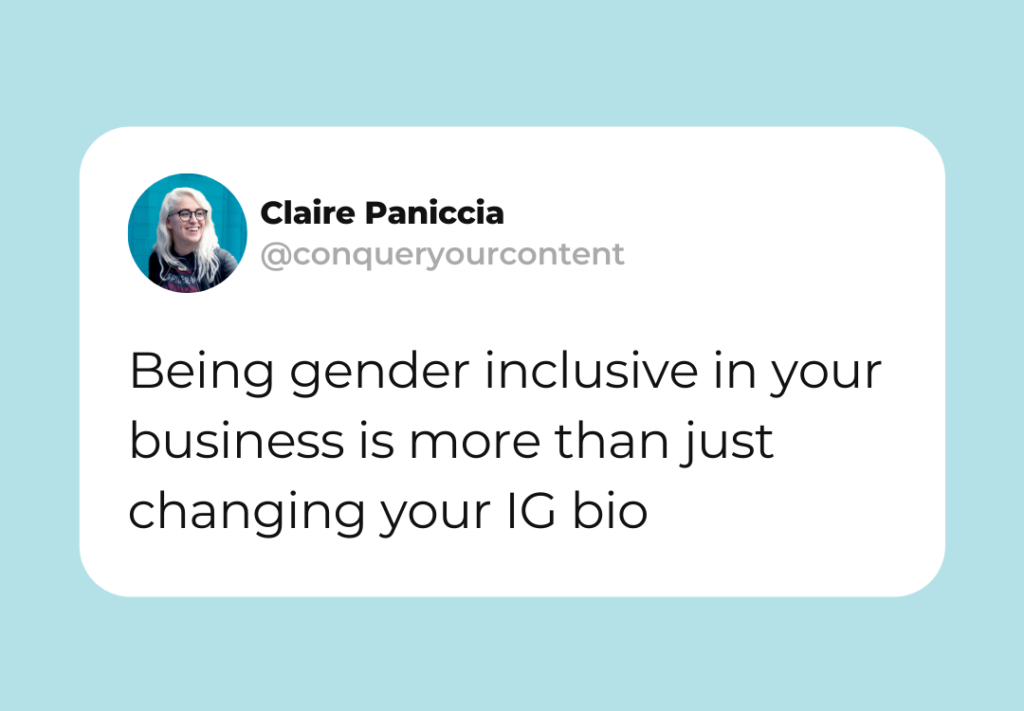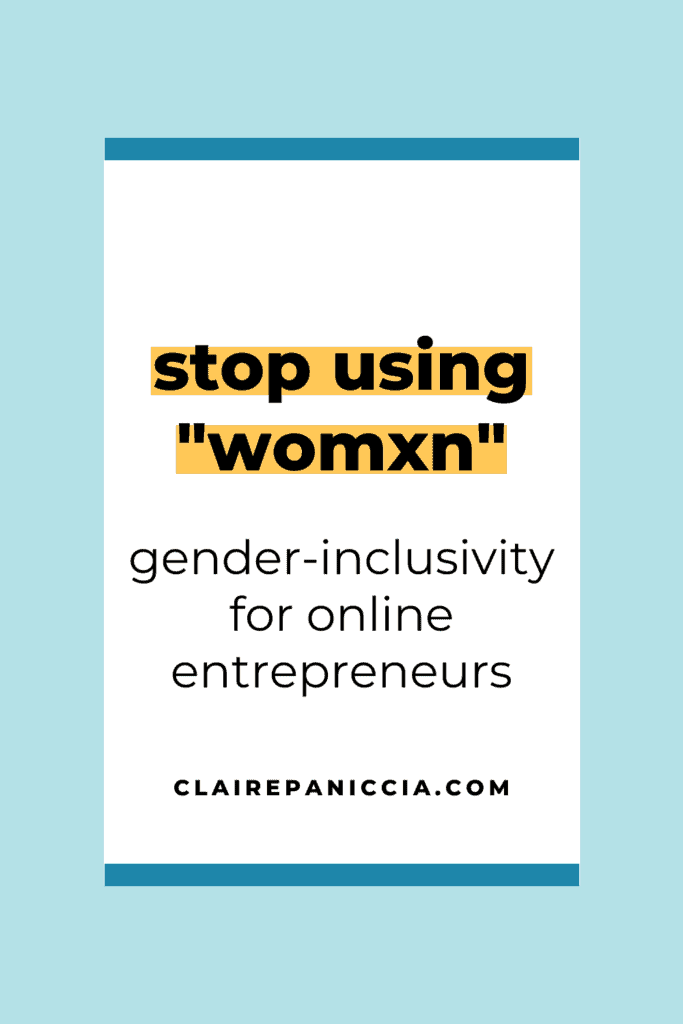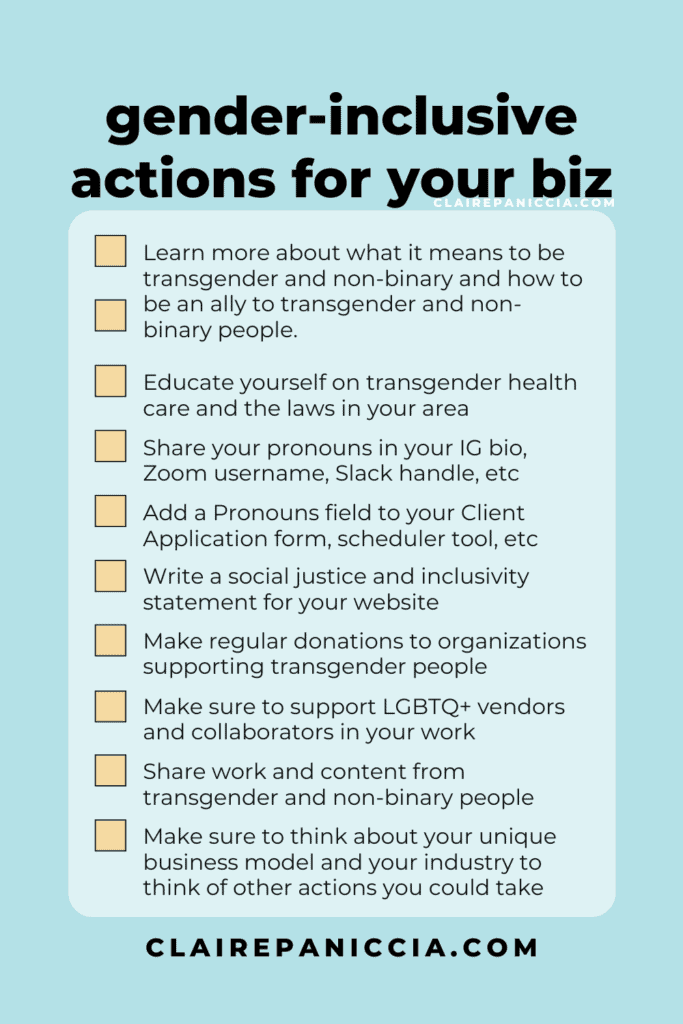I’ve had a lot of conversations with female entrepreneurs who want to be more gender inclusive in their copy or IG bio, but they’re apprehensive about how to go about it because they’ve always said they work with “female ____” or “women ____”
It’s one of my all time favorite conversations to have! I’m a queer, genderfluid, woman-perceived entrepreneur in the (often female) online entrepreneur space.
So I’m always excited to hear when (often straight cis women) entrepreneurs want to be more intentionally inclusive to people like me in their copy.
The conversation almost always starts out with her sharing a lot of anxiety about wanting to be inclusive, but being afraid of saying the wrong thing.
I get it.
That anxiety is real.
But also…
It just means you have more learning to do, and more self reflecting to do.
First, I have to say: I’m so glad you’re thinking about this and want to be more inclusive in your business!
It means that you’re being conscientious and intentional about being values-forward in your business, about showing up as the person you want to be, and doing the good work to actively support marginalized genders.
Those are all incredible, important, amazing things, and I want to celebrate that with you.
But it’s important to be very intentional about it.
Being inclusive means a lot more than just changing a few phrases in your copy or bios.
But before we get into how we go about being gender inclusive in our businesses, and practical things you can do to get started, I want to address something that’s very important.
The word “womxn”
The truth of the matter is: “womxn” isn’t inclusive
“Womxn” isn’t the way to “be inclusive” in your business copy.
At best, it’s lazy.
Most commonly, it’s virtue signaling.
At worst, it’s transphobic.
Here’s the thing about “womxn”
There’s no clear, agreed-upon definition. So none of us really knows what someone means when they use the term.
I’ve talked to a lot of straight cis female entrepreneurs who think it just means “women and trans women” or even just a vague sense of “women but inclusive?”…
It has murky origins (in the 70s, alongside “womyn”, to get rid of the “men” part of “women”, by a generation of feminists who tended to be pretty transphobic), and I have no idea why it’s had a sudden surge in popularity and usage (possibly intended as an offshoot of the use of Latinx as a gender-neutral version of Latina/o).
But at some point last year or two I started seeing it in lots and lots of female entrepreneurs’ Instagram bios.
The thing is, it’s an extremely problematic phrase.
Most importantly, it implies that in order to include trans women, we need to change the spelling of the word, as if they aren’t *really* women, which of course they are.
So that's point #1.
Point #2 is that it’s also not inclusive of gender nonbinary people like me (I identify as genderfluid).
Many people have an unconscious perception of non-binary people, in particular those assigned female at birth (AFAB), as “women lite”.
We’re not. We’re outside the gender binary. And using the phrase “womxn” as a way to try to be inclusive in fact only reinforces that problematic perception.
Unwiring all of these cultural perceptions and understandings of what gender is is deep work. It’s hard.
If you’ve used “womxn” in the past, don’t beat yourself up about it. You were (hopefully) well-meaning, and misstepped. It happens.
But now you know.
Instead, commit to learning more and doing better next time.
Okay, now that we’ve talked about that, let’s talk about what it means to be gender inclusive in your business.
Being inclusive isn’t just about changing your IG bio
Don’t go the lazy route and just change your bio on Instagram and think you're done.
Being gender inclusive in your business is more than just using inclusive language in your copy.
That’s part of it, absolutely.
But it’s also about your mindset, your understanding of the people you're trying to include, your content, and the internal workings of your business, too.
How much do you really know about the trans and queer communities? Are you sharing content in support of these communities on the reg? Do you support queer- and trans-owned businesses with your actual dollars?
Yes, it’s a good thing to find the phrase that most accurately depicts your target audience’s gender (if specifying their gender is actually important to your business)
But what matters even more is backing that up with action.
Are you actually creating an inclusive, welcoming, safe space for these people that you’re trying to include? Are you making it obvious in your content and social media that you support us?
Are you equipped to support transgender and non-binary members of your audience if they enter the world of your business?
Are you taking the small actions to be inclusive in your business processes as well as educating yourself on the deep work?
Let me just tell you now that you are not going to get it perfect right off the bat. And that’s okay.
You have to be okay with that. You will get better incrementally, but only if you put in the effort.
Being inclusive is being an ally, and being an ally takes action and work, and also practice.
What to use instead of “womxn”
Now that we’ve talked about what it means to be truly inclusive in your business, let’s talk about what that looks like and how to go about that in real life.
First, let’s go back to the whole how to define your ideal audience/client thing that we touched on with the word “womxn”
It’s something that a lot of people I’ve talked to are stuck on, so I think it’s important to talk about it directly.
If you’ve always said you work with “female _____” or “women _____”, it can be hard to break away from that language.
But if you find yourself wanting to be gender-inclusive, the term doesn’t fit your business anymore.
Here are some questions I want you to ask yourself to get started:
1. Why are you specifying the gender of your target audience?
Think long and hard about this before you answer it.
There are so many ways to be super specific about your ideal audience in your brand and content without resorting to gender. So really think about it and ask yourself how necessary it really is.
If you decide that specifying the gender of your target audience is in fact necessary for your business, let’s find you some better phrases than “womxn”
To get started, ask yourself these next couple questions, and be suuuuper honest with yourself in your answers.
And if you’re still not clear and feeling murky or muddled, these next questions will help you too.
2. Who EXACTLY am I trying to include?
Trans women? Gender nonbinary people? Feminine people? Vagina-havers? Anyone but straight cis men?
The flip side of this question that’s also worth asking yourself: Who am I trying to exclude?
3. Why EXACTLY am I trying to include them?
Are you a fertility coach who wants to include nonbinary people who menstruate? Does your work speak directly to the experience of growing up in the world as a woman? Is it because you really don’t want to work with men?
The clearer you are on these things, the more confident you’ll be in whatever phrase you choose.
And if you end up realizing that you don’t actually need to specify the gender of your target audience, great! Spend some time reflecting on what actually does define your target audience.
As you do that work, you’ll start to find the other ways to highlight them and draw them in with your copy and content.
Alternative phrases to “womxn” to use in your copy
If you do decide that you need to specify the gender of your target audience, here are some phrases I’ve seen around the internet and heard from other LGBTQ+ people to help you get started with finding your perfect phrase:
“People who menstruate”, “uterus-havers” or “people with uteruses” (could also use “vaginas” instead) >>> this is great for women’s health-related businesses
“Women and feminine-expressing people” (keep in mind this excludes gender-nonconforming women and masculine-expressing nonbinary people)
Or better yet: “People comfortable in feminine spaces” – Credit to @annaparade for sharing this one with me
“Women and gender expansive people” >>> this one is by far my personal favorite. Credit to @erikatebbensconsulting for being the first I ever heard use it
“Women and marginalized genders” >>> pretty much anyone but cis men (though still not including cis gay men)
Other actions you could take to improve the gender-inclusivity of your online business
As I mentioned earlier, being gender-inclusive means more than just changing around some of your copy.
If this is all new territory for you, I understand that it can feel overwhelming jumping in a not knowing what’s what.
Here are some actions to take to improve the gender-inclusivity of your online business, other than tweaking your copy.
- Learn more about what it means to be transgender and non-binary and how to be an ally to transgender and non-binary people. (I have a list that’s a great starting point at this blog post)
- Educate yourself on transgender health care and the laws surrounding it in your area (this is a sad one, but super important), and make sure to share about them on social media and have conversations about them with other people.
- Share your pronouns in your IG bio, Zoom username, Slack handle, and other places online, to normalize sharing pronouns no matter what, and help the internet feel safer for those of us who push gender boundaries.
- Add a Pronouns field to your Client Application form, scheduling tool, or any other forms you use in your business.
- Write a social justice and inclusivity statement for your website to make it 10000% clear to new people exactly where you stand and how you back that up with action.
- Make regular donations to organizations that support transgender and LGBTQ+ people (The Trevor Project is one of my favorites)
- Make sure to support LGBTQ+ vendors and collaborators in your work.
- Share work and content from transgender and non-binary people in your social media – not just content about being LGBTQ+, but content about their expertise or regular things too.
- Make sure to think about your unique business model and your industry to think of other actions you could take as well.
- For example, if you’re a fertility worker, you need to have the ability and knowledge to support transgender men who menstruate.
- If you’re a life coach for women, make sure you’re knowledgeable of the unique struggles that transgender women face in the world, and train yourself on how to respond to those struggles so you don’t do more harm to your client.
- If you run a membership, suggest that everyone adds their pronouns to their usernames, and maybe create an LGBTQ+ subchannel.
This is by no means a complete list, but it’s a good place to get started.
Being gender-inclusive in your business (and life, too!) is an ongoing practice. Each action we all take (especially cisgendered people) helps make the world a better, safer place for people of all genders.
Let me know in the comments if this guide was helpful, and if you have any questions about this!
Shoutout to Erica, friend, client, and artist behind the brand Our Back Pockets, for being a second pair of queer eyes on this guide as I was writing it, since I don't and can't speak for the whole LGBTQ+ community.
